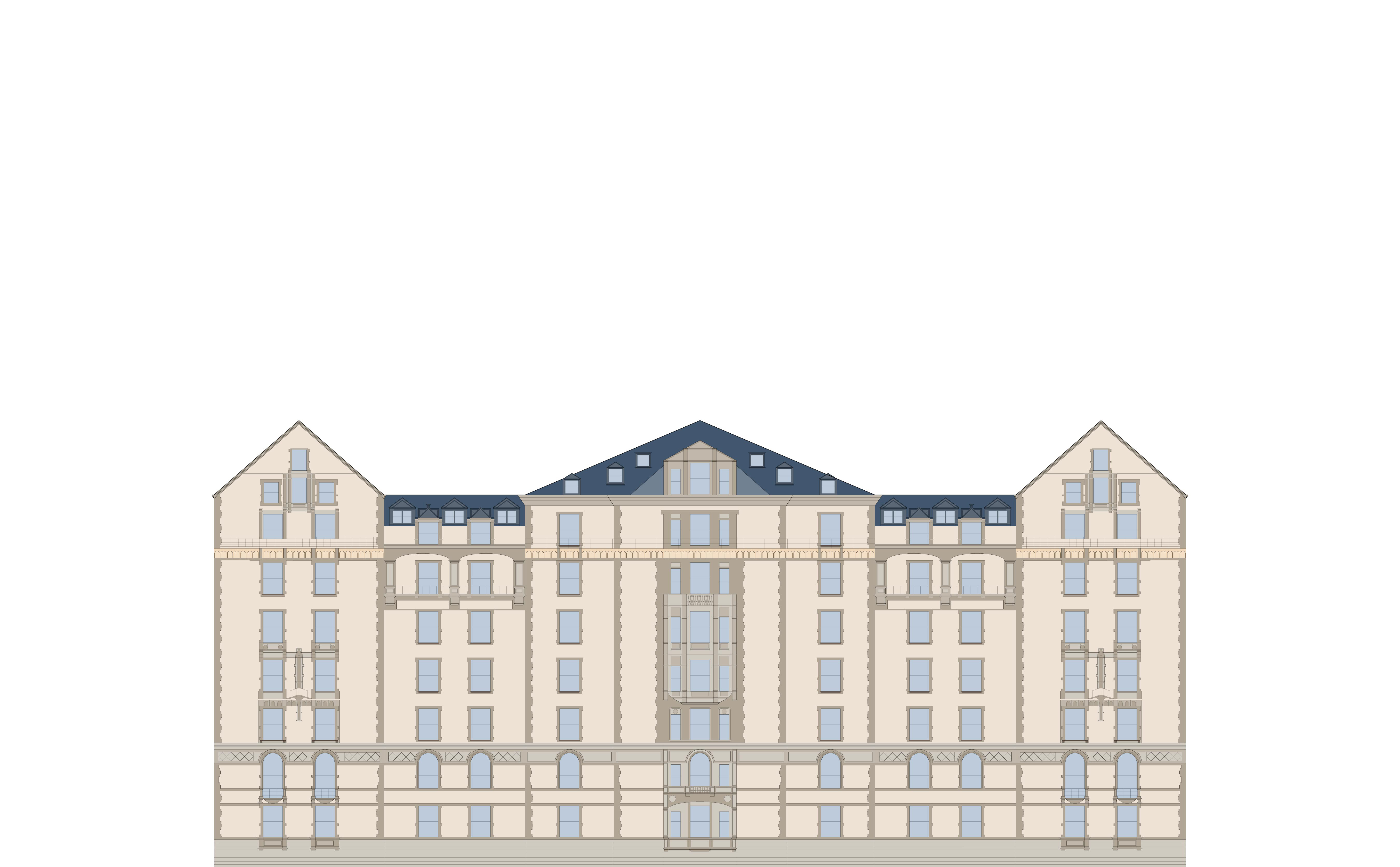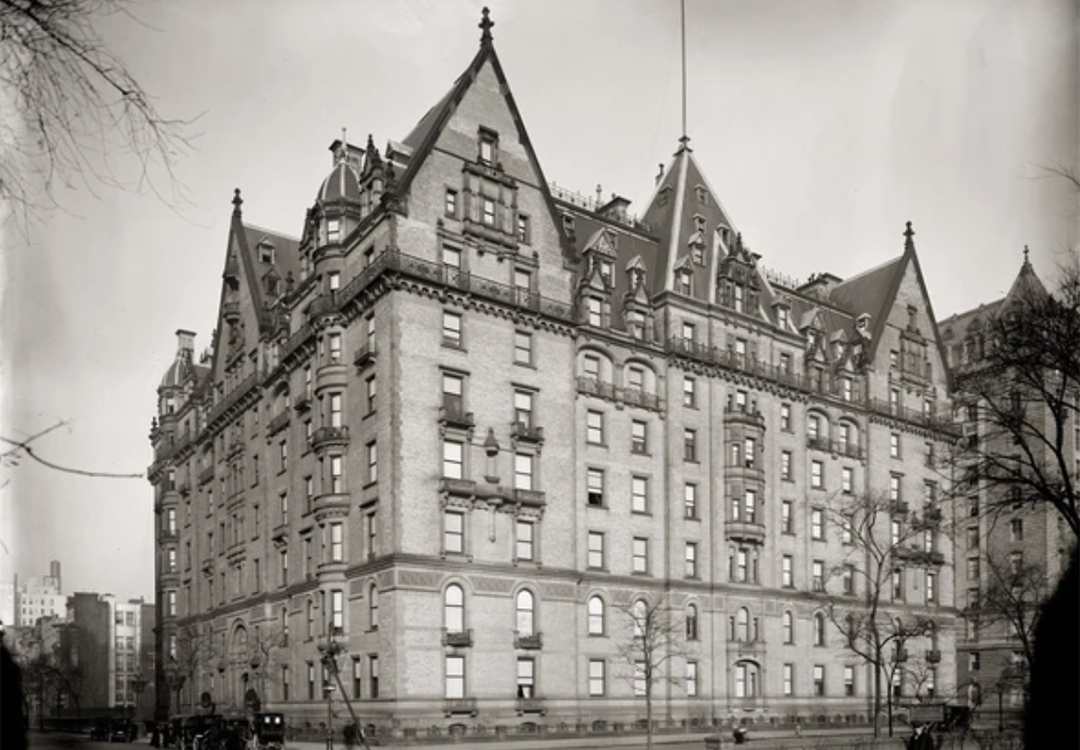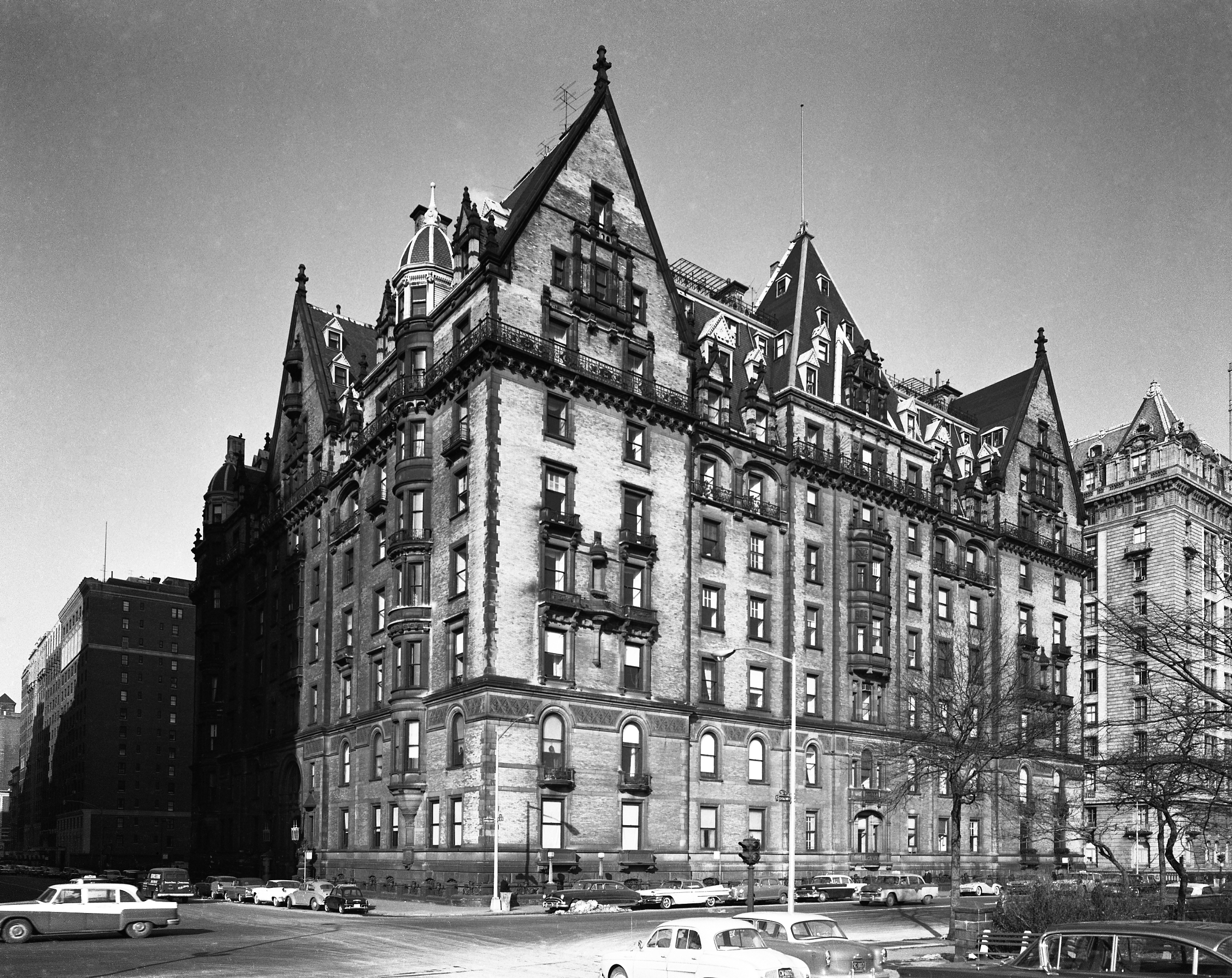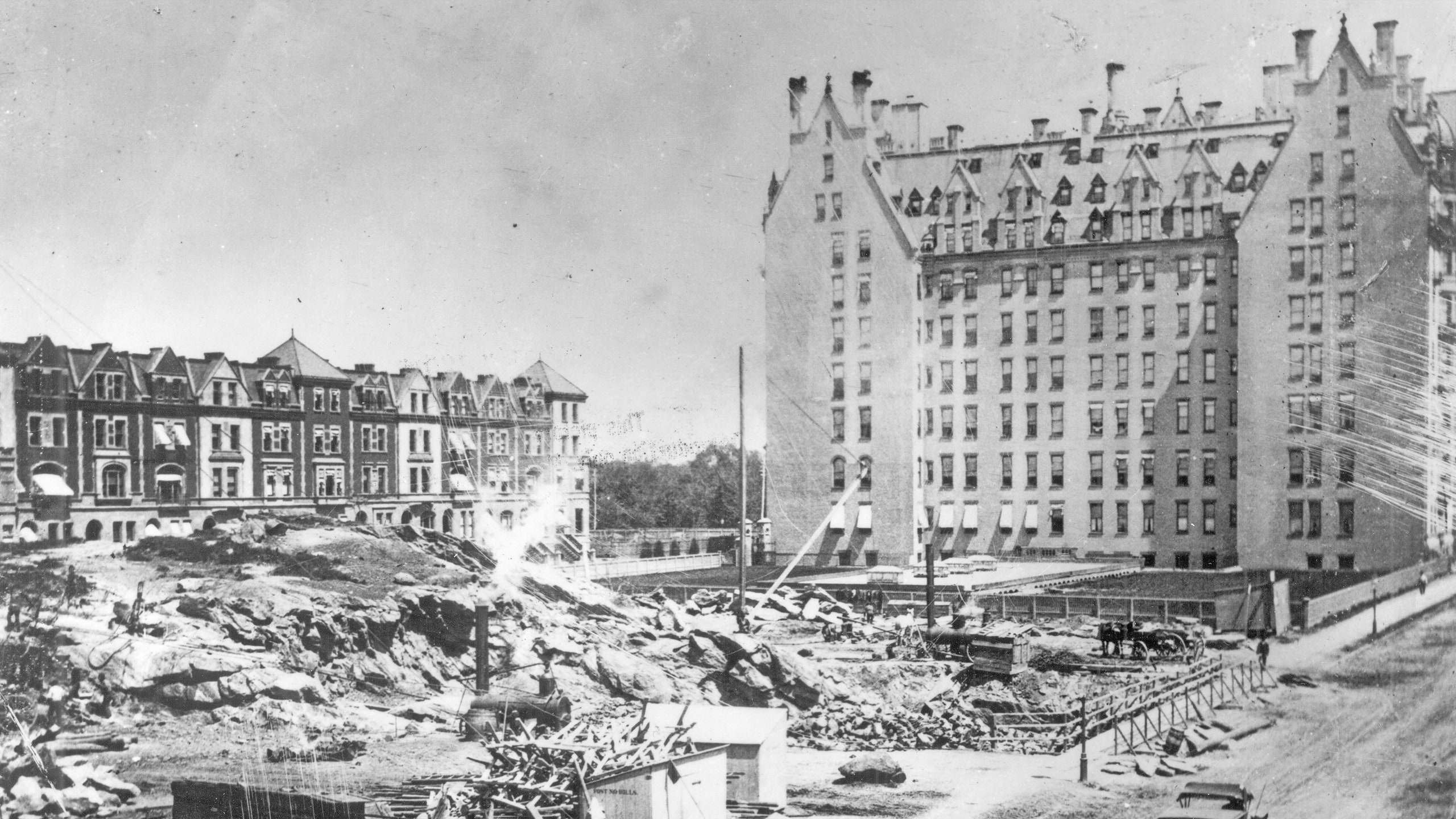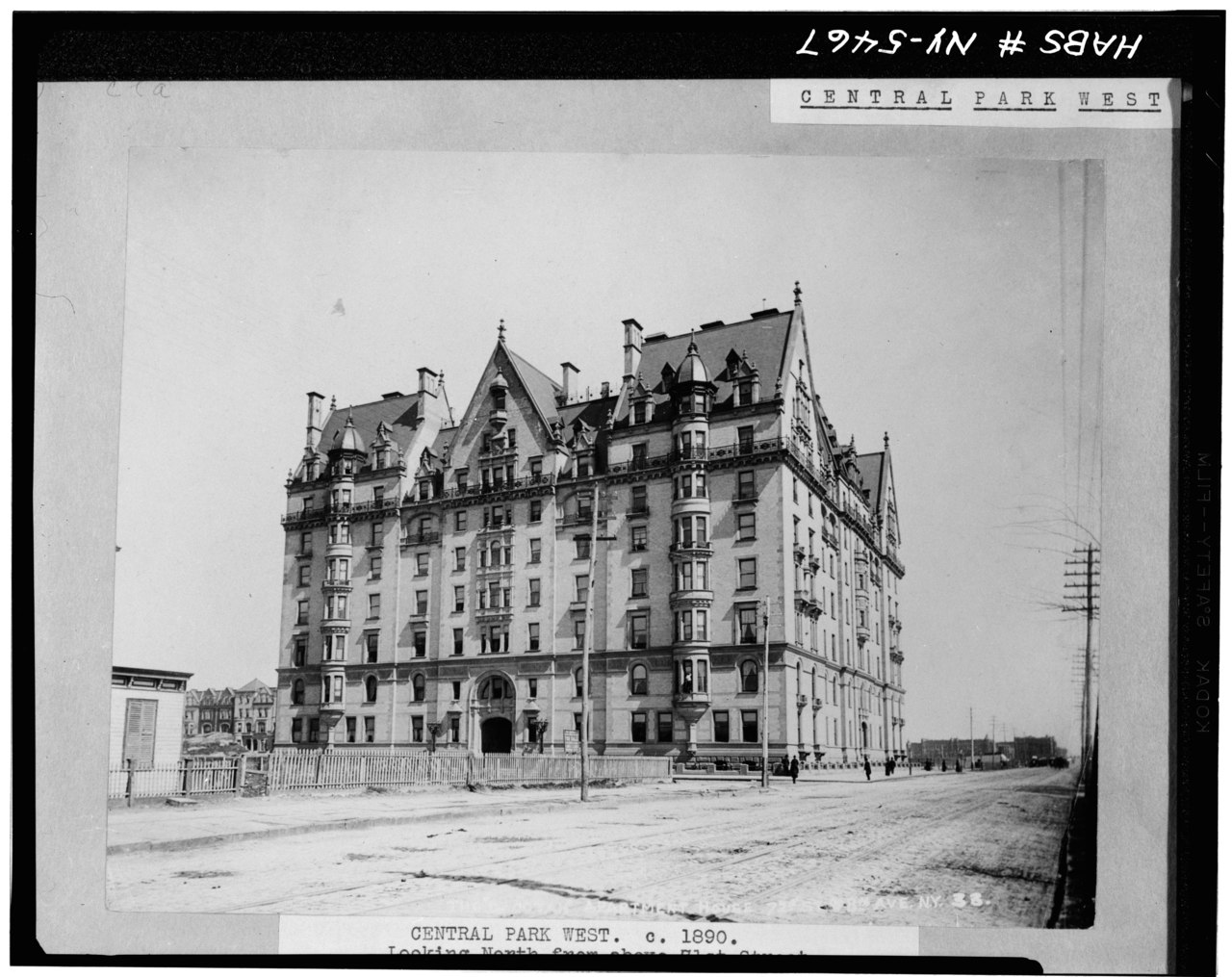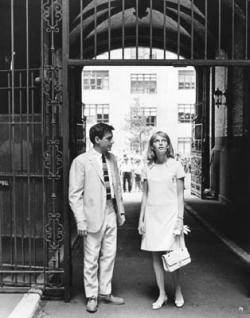
Clark’s Family Hotel
by Tom Miller
Although it was inventor and actor Isaac Merritt Singer who founded the Singer Sewing Machine Company; it was Edward Cabot Clark who made it a success. Clark had been Singer’s attorney since 1848 and the two became business partners. A marketing genius, Clark’s innovative ideas–like accepting trade-ins for newer models–made the Singer Company an enormous success and the partners millionaires.
Edward Clark diversified into real estate development and quickly turned his attention to the rocky, mostly undeveloped Upper West Side. He was outspoken in his intentions to make the West Side as affluent as the East. He encouraged landowners to work together, mutually investing in property, and issuing restrictive covenants on construction.
In 1880 Clark embarked on an ambitious project—the erection of a first-class apartment building that would engulf the blockfront of Eighth Avenue (later Central Park West) between 72nd and 73rd Streets. His speculation was both aggressive and risky. Years later The New York Times would remind its readers that the area “was in the heart of a squatter’s shanty district, where goats and pigs were more frequently encountered than carriages in the muddy streets.”
Architect Henry Janeway Hardenbergh’s plans, filed on October 1, 1880, called for an eight-story “Dorchester stone and brick Family Hotel” with an estimated cost of $1 million (more than 24 times that much in today’s dollars). Clark christened his projected building The Dakota. Manhattan lore is fond of saying that Clark’s friends chided him that it was so far away from the established city it could be in the Dakota Territory. But in fact, the name was almost assuredly merely a product of Clark’s fascination with the West.
Clark was faced with the challenge of attracting moneyed residents to an apartment building at a time when multifamily living was considered middle-class at best. And so, his apartments would offer everything found in an upscale private home. The ceiling heights ranged from 15.5 feet on the first floors to 12 feet at the topmost. No two of the scores of fireplaces were identical, and imposing scale was emphasized throughout the building. Some drawing rooms were 20 by 40 feet, and the parlors, libraries and dining rooms were sumptuous. Floor were inlaid with cherry, oak and mahogany. The Manufacturer and Builder reported that the apartments would have “from five to twenty rooms in each; some are supplied with kitchens, and others have only dining-rooms. On the main floor, at the Eighth avenue and Seventy-second street corner, is to be a large restaurant, including a dining hall and café, with private dining-rooms connected.”
The most lavish apartment was intended for Clark and his family. Its drawing room was the size of a ballroom—24 by 49 feet—with two massive crystal chandeliers and fireplaces at either end. It contained a total of 17 rooms and 17 fireplaces. The expensive details included silver-plated doorknobs and hinges.
To maximize floor space in the apartments, Clark and Hardenbergh had eliminated most of the servants’ rooms and relocated them to the top two floors, which they shared with the laundry and trunk storage rooms. The second floor held apartments for out-of-town guests so the need for guest bedrooms in the apartments was unnecessary, as well.
Clark would never see his apartment completed. On October 14, 1882, Edward C. Clark died of malarial fever, two years before the end of construction. But his project forged ahead without him.
To maximize floor space in the apartments, Clark and Hardenbergh had eliminated most of the servants’ rooms and relocated them to the top two floors, which they shared with the laundry and trunk storage rooms. The second floor held apartments for out-of-town guests so the need for guest bedrooms in the apartments was unnecessary, as well.
In its May 1882 issue The Manufacturer and Builder reported on the progress. “There will be seven hydraulic elevators, and the same number of stairways in iron and marble. The woodwork will be elaborately carved.” Hardenbergh assured residents their privacy by placing the entrances within a gated courtyard. The main carriage gate–a 20-foot high arched entrance–opened onto 72nd Street. On the opposite end of the courtyard was a smaller “tradesmen’s gate” where delivery wagons entered, trash and ashes were removed, and through which the servants came and went. (In the 20th century the tradesmen’s gate received the romantic name “The Undertaker’s Gate,” despite it having most likely never been used for that purpose.)
On October 21, 1882, The Record & Guide described the style as being “in the main, a reminiscence of French Renaissance.” Architectural critics have argued the point for more than a century. It has been described as German Renaissance, Chateauesque, Brewery Brick, and even “Victorian Kremlin.” In fact, it is a melding of historic styles–Hardenbergh’s own hybrid.
The Dakota, which the Record & Guide said was “the very earliest attempt on a large scale to attract fashion to the west side of the park,” was completed in 1884. By then the cost had risen to “between $1,500,000 and $2,000,000,” according to the journal, which added on February 7, 1885, “the rents range from $1,000 to $5,600.”
For that, however, residents enjoyed upscale amenities. Maids arrived every day, as did porters who removed the ashes, and replaced coal and firewood for the stoves and fireplaces. Laundry was taken away and returned freshly cleaned and ironed. The main floor restaurant was in the style of an English baronial hall; but for those tenants who preferred to eat in, meals would be delivered and served by the restaurant staff. On the roof was a promenade with gazebos and pergolas and canopied sunshades. And for the more athletically inclined the adjoining lot to the side held private tennis courts for residents’ use.
On October 27, 1884 the Daily Graphic entitled an article “A Description of One of the Most Perfect Apartment Houses in the World” and called The Dakota “the largest, most substantial, and most conveniently arranged apartment house of the sort in this country.”
Among the early residents were the family of Theodor Steinway, of Steinway & Sons; music publisher Gustav Shirmer and his wife; John Browning, the founder of the Upper West Side’s exclusive Browning School for boys; and Edward Bascomb Harper, president and founder of the Mutual Reserve Fund Life Insurance Company. Others included John D. Adams of the chewing gum firm; and engineer John B. McDonald who built the first subway.
The New York Sun found the extravagance of some residents inexcusable. In an article in May 1890 it complained “A tenant with a five years’ lease in the Dakota flats has spent $5,000 in decorating the walls of his apartment.” (It was a large amount, equal to nearly $150,000 today.) But those who lived in The Dakota could well afford it.
It was no coincidence that Frederick G. Bourne, president of the Singer Sewing Machine Company, had an apartment here. He nearly lost his life on February 23, 1897 when he went for a ride in Central Park. His relaxing jaunt turned terrifying when his saddle horse was spooked and began galloping down the Park Driveway. Bourne was thrown to the pavement, breaking his arm. The Tribune reported “he was taken to his home in the Dakota flats…in a carriage.”
After the turn of the century the laundry was moved from the top floor to a large boiler room under the tennis courts. On the afternoon of April 18, 1910 several employees were at work there, including 52-year old Ellen Cleary, who was working on a steam wringer. Suddenly the massive boiler exploded. The Evening Telegram reported “A huge piece of iron struck her in the leg and she fell to the floor unconscious.” All the other employees ran from the room in panic; but when the danger seemed to have subsided, they rushed back.
“James Williams, an employee of the place, saw the woman was badly injured and made a tourniquet of a sheet, which he placed above the wound to stop the flow of blood.” An ambulance arrived to find that “the Cleary woman’s leg had been almost torn off and was hanging by shreds of flesh. He immediately amputated the limb.” The force of the explosion had broken out several of the lower floor windows.
The tradition of the heads of the Singer Sewing Machine Company residing in The Dakota continued with Sir Douglas Alexander and his wife, the former Helen Hamilton Gillespie. Alexander was the sixth president of the firm which he had joined as a clerk in his native Canada in 1891. Upon his appointment to the Board of Directors in 1896 the couple moved to New York. He was created a baronet of Edgehill, near Stamford, Connecticut, on July 2, 1921 by King George V. Lady Alexander died in their Dakota apartment on March 19, 1923.
By 1959 the tenant list, while still highly affluent, had somewhat changed. Nan Robertson, writing in The New York Times on September 7, 1959 grouped the residents into three categories: “the diplomatic corps, upper-echelon show business and publishing.”
By 1959 the tenant list, while still highly affluent, had somewhat changed. Nan Robertson, writing in The New York Times on September 7, 1959 grouped the residents into three categories: “the diplomatic corps, upper-echelon show business and publishing.” Included in the diplomatic contingent were the ambassadors to the United States of the Netherlands, Portugal, Finland, and the former Ambassador from the Soviet Union. “Theatrical tenants, to name a few,” said the article, “are Boris Karloff, Eric Portman, Judy Holliday, José Ferrer and his wife, Rosemary Clooney, Zachary Scott and his wife, Ruth Ford, Jo Mielziner, the set designer, and Sidney Kinglsey, the playwright.” C. D. Jackson, a top executive of Time, Inc. occupied the 17-room Edward C. Clark apartment on the sixth floor.
The Dakota still maintained a staff of 52, described by Robertson as “like wondrous fossils from the Age of Gracious Living.” And it was still owned by the Clark family. One resident said “You never saw a building so superbly maintained. The bronze is petted, the mahogany oiled, the brass rubbed, the floors waxed.” By now the former warren of servants rooms on the eighth and ninth floors were rented “to a chosen few tenants for $25 to $30 a month.”
With motion picture stars inside, The Dakota became a film celebrity in its own right in 1968 when it served as the location of Roman Polanski’s psychological horror film Rosemary’s Baby.
In 1973 singer John Lennon and his wife, Yoko Ono moved into an apartment, adding their names those of other famous residents like Leonard Bernstein, Roberta Flack and Lauren Bacall. Two years later, on January 26, 1975 a catty journalist suggested that the two had split up, writing in the Twin Falls, Idaho newspaper “Yoko still lives in their expensive New York City Dakota Apartment and drives around town in the Lennon limo. John is hanging out with a swinging black dancer on Manhattan’s West Side.”
Seven years later the couple had acquired five apartments consisting of 26 rooms, plus a ground-floor office. On the night of December 8, 1980, the Lennons left the building. A fan, Mark Chapman, approached John and asked him to autograph a copy of “Double Fantasy,” Lennon’s latest album. He did so, writing “John Lennon 1980.” Several hours later the Lennons returned home. John stepped back through the gate to the crowd of fans to sign autographs. Chapman was still here and he emptied his .38-calibre pistol into Lennon’s back and left arm. The former Beatle was pronounced dead upon arrival at the hospital.
Today The Dakota is regarded as America’s second most famous address—the first being 1600 Pennsylvania Avenue. While almost every other Victorian apartment house fell from fashion or, more often, was demolished, The Dakota has never lost its upscale reputation. And, also unlike most, its interiors are for the most part secured. Residents who wish to modernize their apartments are required to store any architectural elements—like mantels or woodwork–so they can be reinstalled later.
Tom Miller is a social historian and blogger at daytoninmanhattan.blogspot.com
LEARN MORE ABOUT
1 West 72nd Street, The Dakota
Landmarks Timeline
Next Stop
Landmarks Designation
Explore Even More!
Read more about this landmark from our partners at the NYC LGBT Historic Sites Project!
NYC LGBT Historic Sites Project Site History
